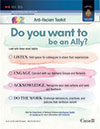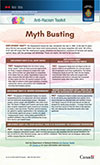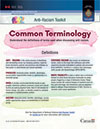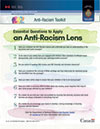Anti-racism tips and tools
Tips and tools to help you understand how to talk and work with and support Defence Team members of diverse racial backgrounds.
Tips and tools
Quick tips and insights to help you learn how you can make a difference.
Tips on how to be an ally
Do you want to be an ally? Lead with these small habits:
- Listen: Hold space for colleagues to share their experiences.
- Engage: Connect with Defence Team Advisory Groups and Networks.
- Acknowledge: Recognize your own actions and seek out feedback.
- Do the work: Challenge behaviours, practices and policies that reinforce racism.
Download or print a PDF of the tip sheet:
Tips on how to have courageous conversations
Start the conversation
Engaging in dialogue is the first step to understanding one another. The goal of these conversations is to raise awareness and build empathy.
Use the BRAVE framework
The build, respect, acknowledge, validate and emphasize (BRAVE) framework is a useful tool that provides strategies to explore when having courageous conversations at all levels of an organization.
- Build the intention, focus, and safety needed to have honest conversations about race.
- Respect the sensitivity of the topic while challenging people to go beyond the superficial. Everyone needs to respect each other's boundaries.
- Acknowledge the uncomfortable realities of the past and the present.
- Validate and accept the experiences of your racially marginalized colleagues. Productive conversations require acknowledging the reality of racism and racial discrimination.
- Emphasize how your organization is prioritizing goals and measuring success around racial equity.
- For more tips, see Guide to having courageous conversations about racism and discrimination.
Tips on how to bust myths
The Employment Equity Act was introduced into law in 1995. In the last 25 years since the Act was passed, there have been some advancements, but many inequities still exist. Yet critics of employment equity will still argue that the employment equity initiatives are themselves violations of fairness and equity against those with the privilege and advantage. These are myths, but need to be countered.
Commonly held myths about employment equity
Myth – Employment equity is all about quotas
Fact: Employment equity does not impact on the employer's ability to set qualifications for a job and require that all applicants meet those qualifications. The Federal Employment Equity Act and the Public Service Employment Act both reflect this reality and recognize that qualifications and merit are concepts that incorporate employment equity rather than conflict it.
Myth – Employment equity is "reverse discrimination"
Fact: The purpose of employment equity is to remove longstanding barriers to employment and career advancement for historically disadvantaged groups—Aboriginal peoples, women, people with disabilities, and visible minorities. The Charter of Rights and Freedoms and human rights laws recognize employment equity measures are necessary to create a more just society.
Special measures are applied for opportunities in the workplace, not to discriminate against one group or another. It is about "rebalancing the scales" and providing opportunities for qualified candidates who are often overlooked due to systemic barriers and implicit biases.
Myth – Employment equity means hiring unqualified people
Fact: Employment equity does not impact on the employer's ability to set qualifications for a job and require that all applicants meet those qualifications.
The Federal Employment Equity Act and the Public Service Employment Act both reflect this reality and recognize that qualifications and merit are concepts that incorporate employment equity rather than conflict with it.
Employment equity is about removing barriers in hiring practices to ensure that otherwise qualified designated group members are not denied jobs based on factors unrelated to their ability.
Myth – Because of employment equity, there are no more job opportunities for White applicants
Fact: Employment equity measures do not mean that all new jobs are designed for equity-seeking group members. It simply means that they must have access to their fair share of opportunities, and reducing the favouritism towards white male applicants.
Myth – Employment equity will occur naturally, there is no requirement for government intervention
Fact: 25 years after employment equity was initiated, we know that discrimination exists and that barriers continue for women, Indigenous (Aboriginal) peoples, visible minorities and persons with disabilities (the four groups identified in the Act), as well as for other such as LGBTQ2+ employees. These barriers will not disappear without intervention, because they have not done so.
Download or print a PDF of the tip sheet:
Common anti-racism terminology
Understand the definitions of terms used when discussing anti-racism.
Anti-racism
Is the active process of identifying and eliminating racism by changing systems, organizational structures, policies and practices and attitudes, so that power is redistributed and shared equitably.
Privilege
Unearned power, benefits, advantages, access and/or opportunities based on membership in a dominant group.
Race
A socially-constructed identity based on geographic, historical, political, economic, social and cultural factors, as well as physical traits. Race is not intrinsic to human beings, but rather an identity created to establish meaning in a social/economic context.
Racism
Any individual action, or institutional practice which treats people differently because of their colour or ethnicity. This distinction is often used to justify discrimination.
Systemic racism
Also known as institutional racism, refers to the ways that whiteness and white superiority become embedded in policies and processes of an institution, resulting in a system that advantages white people and disadvantages Black, Indigenous, and People of Colour (BIPOC)/IBPOC.
White fragility
A state in which even a minimum amount of racial stress becomes intolerable (for white people), triggering a range of defensive moves. These moves include the outward display of emotions such as fear, guilt and anger and behaviours such as argumentation or silence. These behaviours, in turn, function to reinstate white racial equilibrium.
Download or print a PDF of the tip sheet:
For more definitions, you can consult the anti-racism lexicon.
Essential questions to apply an anti-racism lens
- Have you reviewed the anti-racism lexicon and confirmed you have an understanding of the key terms and concepts?
- To the best of your ability, have you engaged with Defence Team members of different racial backgrounds, prior to and during your planning/creation process?
- Are you aware of existing Department of National Defence (DND) public service employee and Canadian Armed Forces (CAF) diversity and inclusion resources?
- Have you considered the concepts of White privilege and how historically the dominant group has benefitted from this privilege?
- Have you taken active steps to ensure that your initiative is fair to all racial groups?
- Have you made a conscious effort to think about any existing racial inequities that may impact racial groups affected by your initiative?
- As a leader, do you hold your teams accountable by ensuring that diversity, inclusion and racial fairness are always embedded in everything they do?
- As a leader, do you encourage your teams to develop a strong knowledge of inclusion, diversity, equity and anti-racism?



